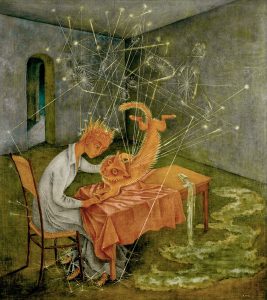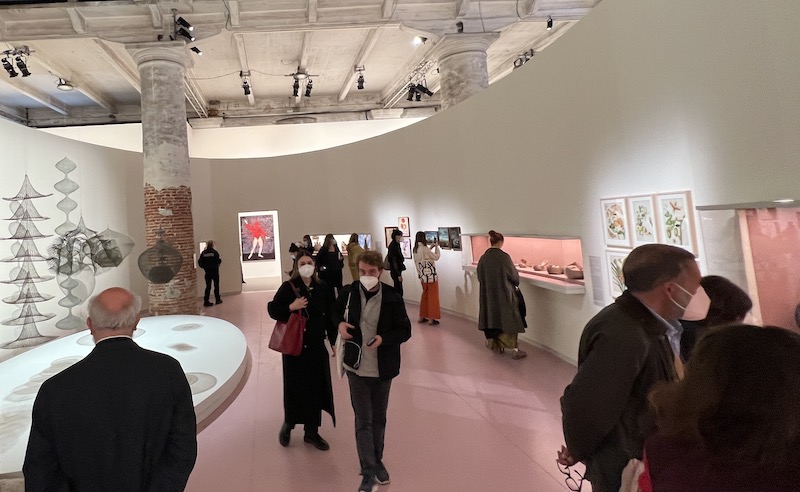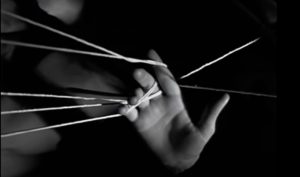“Can you hear me Marian?”
Indeed I could, it was terrifying.
-Leonora Carrington, The Hearing Trumpet
Amidst the disorientation that follows our re-emergence from an extended period of isolation and uncertainty, curator Cecilia Alemani presents Milk of Dreams, a large-scale matriarchal gathering bringing the work of over 200 contemporary artists from 58 countries to Venice, together with works by a selection of historical female artists from the 19th century onwards.
The resulting exhibition places egotistical curatorial statements second to the desire to set generations of artists in dialogue with each other. Its ‘trans-historical’ scope was made possible by the show’s year-long delay, but also constitutes a response to it – offering a moment of repose and reconnection. In this, Alemani looks especially to the 1948 ‘rebirth’ Biennale – the first edition after World War Two, which followed a six-year hiatus. Like the current edition, 1948 introduced many new contemporary artists while simultaneously looking back at history to include those who had been censored or obscured by fascist regimes.
The earlier works are arranged into five ‘time capsules’, miniature worlds staggered through the show, set apart by abrupt switches in exhibition design. In the first of these, nestled in a subterranean layer beneath the Giardini’s central Pavilion, I stand transfixed by Ukrainian-American film-poet Maya Deren’s unfinished film Witch’s Cradle (1943), screened overhead like a kind of ecstatic vision. It depicts two actors – one Pajorita Matta, another Marcel Duchamp – involved in a series of bizarre, fragmentary rituals. Their bodies are seemingly interconnected – at a distance – by the motions of an animated piece of string, which crawls up legs and around necks, at one point entangling the hands of Duchamp in what appears to be a chaotic, solitary game of cat’s cradle. Matta moves as if in a trance through a series of low-lit rooms, a cyclical mantra imprinted on her forehead reading ‘the beginning is the end is the beginning…’. At one point in the film, the string appears to cast large webs through entire rooms of what was in fact Peggy Guggenheim’s Art of This Century gallery, incorporating a number of surrealist paintings and sculptures which happened to be on show at the time.
This strange, incomplete work presents a kind of portal through which the show’s guiding themes and curatorial impetus can be understood. Assembled by archival staff after Deren’s death, the film’s very production (like its title) evokes the game cat’s cradle – where a long string loop suspended between the fingers is sequentially transformed from one complex figure to the next, as it is passed between players. The game ends when a player makes a mistake or creates a ‘dead-end’ figure. And yet, even such dead-end figures may be maneuvered into something new.
In the face of an apparent existential ‘dead end’, the philosophy of post-humanism is explored by the show as a new way of re-conceptualising and narrating our inter-connectedness to other bodies, species and substances. As a future-oriented look at the present, much of the work is also deeply entrenched in ancient methods, perhaps most of all that of alchemical transformation. The key premise of alchemy, like post-humanism, (and the game cat’s cradle) is this inter-connectedness of things which underlies the possibility of transforming one thing into another, through new re-combinations and methods.

Akin to a literalisation or visualization of this alchemical principle, webs of various kinds seem to recur as a subtle leitmotif throughout Alemani’s exhibition. Near Deren’s work, in a painting by Remedios Varos (Sympathy. Madness of the Cat, 1955) an encounter between a woman and a cat (who has incidentally just spilt a large glass of milk) triggers a ricochet of electric white sparks and a web-work of white lines around the figures, seeming to connect them to some kind of cosmological network. Nearby stands Alice Rahon’s The Juggler (1946), a marionette – whose figure lies somewhere between human form and spider’s web – from a post-apocalyptic play written shortly after the bombing of Hiroshima, contemplating life after the end of the world. Elsewhere, Georgiana Houghton’s spiritual incantations (from 1867/1866) layer thin networks of white spiralling threads over kaleidoscopic watercolours.
Amongst the contemporary works on show, such web-works recur on a larger scale through several installations. Towards the end of the Giardini, detritus and washed-up items collected from the Venetian lagoon are cast in suspension among sailors’ ropes hung from the ceiling, in a work of surprising delicacy by Cecilia Vicuña, entitled NAUfraga (2022). This ‘homage to the Venetian lagoon and its fragile ecosystem’ is what Vicuña refers to as a precario – a precarious, constellation-like assemblage of things collected from the vestiges of human activity. It is surrounded by an array of her paintings from the 1970s to now, depicting metamorphosing, hybrid beings in light, bright colours. Three towering figures sculpted from rope by Mrinalini Mukherjee, using ancient Arabic hand-knotting techniques, stand at the far end of the room, surveying those who pass through.
In the Arsenale, Delcy Morelos has constructed a raised maze of moist earth (Earthly Paradise, 2022) scented with hay, cassava flour, cacao powder, cloves and cinnamon spices. Its simplicity of structure and orderly form seem to heighten, by contrast, its olfactory presence, which permeates you as you walk through it. Towards the end of the Arsenale complex, Precious Okoyomon’s To See The Earth Before the End of the World (2022) presents a self-contained yet leaky microcosmic garden. In both works, the remodelling of an earthy ‘materia prima’ into an immersive, labyrinthine form serves as a reminder of our inescapable inter-dependency and symbiosis with other beings and materials – as well as the inevitability of entropic change, and regrowth.
Crucially, rather than side-stepping the human, Alemani’s ‘post-human’ exhibition presents the body and its interconnections as all the more immanent. Visions of a future-oriented magic realism are grounded in milky viscerality – everything is somatic, weighted by the body. Whirling accelerationist futurism and disinfected transcendence is replaced by a look sideways, in a reminder of those social, organic and inorganic webs within which we are spun.
In a show focusing specifically on portrayals of bodies and things always at the cusp of transforming or metamorphosing into something else, it makes sense that painting – perhaps the most alchemical of all artistic media – plays an important role. At the entrance to the Giardini, Katarina Fritsch’s life-sized cast of an elephant stands on a mirrored stage (Elefant/Elephant, 1987), its flesh coated with a strangely matt, almost iridescent green paint. New paintings by Miriam Cahn, in a series called Unser Suden Sommer 2021, 5.8.2021 (2021), expand and blur the edges and boundaries of bodily figures into uncertainty and ambiguity in the most striking, visceral way. The incorporation of unusual materials to this end is perhaps epitomised by the late Kaari Upson’s Portrait (Vain German) (2020-1) series of iterative casts onto which are painted magenta, mustard and fluorescent green pigments, suspended in urethane and resin – using substances associated with preserving or enhancing to present distortion and ambiguity.
The act of painting itself forms one kind of human-lithic interface, a mergence explored also in the lead crystal sculptures of Andra Ursuta, presenting hyper-mutated, hybrid beings (Predators ‘R Us, 2020). Elsewhere in the Giardini, works by Julia Philips and Hannah Levy present bodily form through its absence, again implying new switch-points between organic form and inorganic substance.
A recurring focus among the historical works is on the somatic knowledge underlying artists’ use of materials. A sensory-led experimental approach to material transformation – as in alchemical practices – takes precedence over speculative philosophy. In the Giardini, the ‘time capsule’ Corps Orbite presents works of visual and concrete poetry where writing is explored as an embodied practice, ranging from non-linear poetic emanations by Josefa Tola, Urica Zurn, Mary Ellen Solt and Ilse Garner, to Milly Canavero and Georgiana Houghton’s documentations of spiritual experience. This section is in part a response to Mirella Bentivoglio’s exhibition Materializzazione del Linguaggio, the so-called ‘pink ghetto’ of the 38th Venice Biennale (1978). Technologies of Enchantment attends to the skin-like screen surface as a bodily interface, and alternatives to today’s algorithmic entrapment in the earlier, pre-internet optimism of 1960s cybernetics and ‘programmed art’.

The Arsenale’s ‘capsules’ include A leaf a gourd a shell a net a bag a sling a bottle a pot a box a container, which presents a Le-Guin inspired iconology of vessels and containers; and Seduction of the Cyborg, where painted prostheses for war victims (by Anna Coleman Ladd) are displayed alongside works documenting the self-styled personae of figures such as Elsa von Freytag-Loringhoven, Florence Henri and Karla Grosch. This section also presents a startling work by Rebecca Horn, Kiss of the Rhinoceros (1989): two enormous metal arms, each tipped with a metal rhinoceros horn which, when they reach one another at the apex of the circle, exchange a bolt of electricity. Yet here, the two horns are static and at rest – which speaks to a moment of repose and reflection, amidst this presentation of what (to use a term less suggestive of linear progression) might be called ‘alter-humanisms’.
It is clear that Alemani, in directing our gaze towards an earlier generation of artists as ‘guides’ for orientation, is not suggesting we look back to them for straightforward inspiration as to how to ‘move forwards’. These figures, and their works, are themselves continually shifting, metamorphosing, developing before our eyes – and the presentation of the ‘time capsules’ seems intent on deconstructing, rather than narrating, linearity.
In many of these works, artists’ bodies often seem entangled and merged in a more intimate, ambiguous and less unitary ‘presentation of self’ than seemed possible later in the century, when selfhood and its idealised singular bounds became heightened, leading to today’s hyper-individualised societies and a constantly ‘on brand’ performance of individualism.
Alemani takes Leonora Carrington as the leading historical figure in her show, an artist whose practice merged esotericism and syncretic cultural traditions with personal mythologies in a way that perhaps prefigures not only the contemporary ‘pick and mix’ approach of so many New Age devotees’ belief systems, but also the highly self-aware personal myth-building of so many contemporary artists. Yet it is less the artist herself on whom Alemani’s focus lies, rather the hybrid, metamorphosing characters that populate her writings. The troubled fates of these dreamlike figures speak to a paradox confronting contemporary illusions of the bounded individual. To be connected also means to be inter-connected, entangled, enmeshed. A recognition which, through its historical and contemporary iterations, presents simultaneously a suffocating entanglement, and a liberating awareness of co-existence.
In the quote above, taken from Leonora Carrington’s novel The Hearing Trumpet, one such character – a 92-year-old Marian Leatherby – is unexpectedly reconnected to the world of sound by a Jacobean hearing trumpet. Yet, her initial reaction is not one of joy, but of shock at the disorienting loudness of an amplified interface with the world. It is through this prosthesis of reconnection that Marian soon hears of her imminent exile to a home for the elderly. Upon arrival – in a curious parallel with the Biennale event – she takes her place amidst an eccentric community of elderly women, all working behind the scenes (housed in a strange series of ‘pavilion’-like buildings, ersatz toadstools, birthday cakes, a giant shoe and an igloo) in an attempt to re-connect with a more meaningful world, beyond the human…


